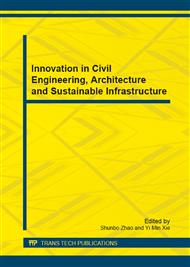p.565
p.572
p.576
p.581
p.585
p.589
p.593
p.599
p.603
Wind-Induced Response Analysis of Steel Tower Structure
Abstract:
In this paper, autoregressive (AR) method is firstly introduced to simulate wind speed time series. The agreement of the simulated wind speed spectrum to the target spectrum is verified. A 42m-high steel tower subjected to wind load is analyzed using ANSYS. Through modal analysis, it can be found that the first several modes of the structure are all translational vibration modes. Torsional vibration modes and local vibration modes appear from the 3th order mode. Meanwhile, time history analysis is applied to analyze the structural response. Results show that, under wind loads, the steel tower has large stresses in the chords which have abrupt section area change.
Info:
Periodical:
Pages:
585-588
Citation:
Online since:
November 2012
Authors:
Price:
Сopyright:
© 2012 Trans Tech Publications Ltd. All Rights Reserved
Share:
Citation:


